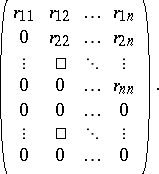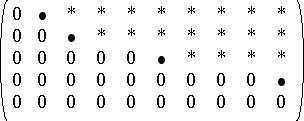Matrix factorization
factorization of matrices
Factorizations of matrices over a field are useful in quite a number of problems, both analytical and numerical; for example, in the (numerical) solution of linear equations and eigenvalue problems. A few well-known factorizations are listed below.
 -factorization.
-factorization.
Let  be an
be an  -matrix with
-matrix with  over
over  . Then there exist a unitary
. Then there exist a unitary  -matrix
-matrix  and a right-triangular
and a right-triangular  -matrix
-matrix  such that
such that  . Here, a right-triangular
. Here, a right-triangular  -matrix,
-matrix,  , is of the form
, is of the form
 |
A real (respectively, complex) non-singular matrix  has a factorization
has a factorization  with
with  orthogonal (respectively, unitary) and
orthogonal (respectively, unitary) and  having all elements positive. Such a factorization is unique and given by the Gram–Schmidt orthogonalization process (cf. Orthogonalization method). The frequently used
having all elements positive. Such a factorization is unique and given by the Gram–Schmidt orthogonalization process (cf. Orthogonalization method). The frequently used  -algorithm for eigenvalue problems (cf. Iteration methods) is based on repeated
-algorithm for eigenvalue problems (cf. Iteration methods) is based on repeated  -factorization.
-factorization.
Singular value factorization.
Let  be an
be an  -matrix over
-matrix over  of rank
of rank  . Then it can be written as
. Then it can be written as  , with
, with  a unitary
a unitary  -matrix,
-matrix,  a unitary
a unitary  -matrix and
-matrix and  of the form
of the form
 |
where  is diagonal with as entries the singular values
is diagonal with as entries the singular values  of
of  , i.e. the positive square roots of the eigenvalues of
, i.e. the positive square roots of the eigenvalues of  (equivalently, of
(equivalently, of  ).
).
 -factorization.
-factorization.
An  -matrix
-matrix  (over a field) such that the leading principal minors are non-zero,
(over a field) such that the leading principal minors are non-zero,
 |
can be written as a product  with
with  a lower-triangular matrix and
a lower-triangular matrix and  an upper-triangular matrix. This is also known as triangular factorization. This factorization is unique if the diagonal elements of
an upper-triangular matrix. This is also known as triangular factorization. This factorization is unique if the diagonal elements of  (respectively,
(respectively,  ) are specified (e.g., all equal to
) are specified (e.g., all equal to  ); see, e.g., [a2], p. 821. Conversely, if
); see, e.g., [a2], p. 821. Conversely, if  is invertible and
is invertible and  , then all leading principal minors are non-zero.
, then all leading principal minors are non-zero.
In general, permutations of rows (or columns) are needed to obtain a triangular factorization. For any  -matrix there are a permutation matrix
-matrix there are a permutation matrix  , a lower-triangular matrix
, a lower-triangular matrix  with unit diagonal and an
with unit diagonal and an  echelon matrix
echelon matrix  such that
such that  . Here, an echelon matrix can be described as follows:
. Here, an echelon matrix can be described as follows:
i) the non-zero rows come first (the first non-zero entry in a row is sometimes called a pivot);
ii) below each pivot is a column of zeros;
iii) each pivot lies to the right of the pivot in the row above. For example,
 |
where the pivots are denoted by  .
.  -factorization is tightly connected with Gaussian elimination, see Gauss method and [a3].
-factorization is tightly connected with Gaussian elimination, see Gauss method and [a3].
Iwasawa decomposition.
The  -factorization for real non-singular matrices immediately leads to the Iwasawa factorization
-factorization for real non-singular matrices immediately leads to the Iwasawa factorization  with
with  orthogonal,
orthogonal,  diagonal and
diagonal and  an upper (or lower) triangular matrix with
an upper (or lower) triangular matrix with  s on the diagonal, giving an Iwasawa decomposition for any non-compact real semi-simple Lie group.
s on the diagonal, giving an Iwasawa decomposition for any non-compact real semi-simple Lie group.
Choleski factorization.
For each Hermitean positive-definite matrix  over
over  (i.e.,
(i.e.,  ,
,  for all
for all  ) there is a unique lower-triangular matrix
) there is a unique lower-triangular matrix  with positive diagonal entries such that
with positive diagonal entries such that  . If
. If  is real, so is
is real, so is  . See, e.g., [a4], p. 180ff. This
. See, e.g., [a4], p. 180ff. This  is called a Choleski factor. An incomplete Choleski factorization of a real positive-definite symmetric
is called a Choleski factor. An incomplete Choleski factorization of a real positive-definite symmetric  is a factorization of
is a factorization of  as
as  with
with  a positive-definite diagonal matrix and
a positive-definite diagonal matrix and  lower-triangular.
lower-triangular.
Decomposition of matrices.
Instead of "factorization" , the word "decomposition" is also used: Choleski decomposition,  -decomposition,
-decomposition,  -decomposition, triangular decomposition.
-decomposition, triangular decomposition.
However, decomposition of matrices can also mean, e.g., block decomposition in block-triangular form:
 |
and a decomposable matrix is generally understood to mean a matrix that, via a similarity transformation, can be brought to the form
 |
Still other notions of decomposable matrix exist, cf., e.g., [a10].
Matrices over function fields.
For matrices over function fields there are (in addition) other types of factorizations that are important. E.g., let  be an
be an  -matrix with coefficients in the field of rational functions
-matrix with coefficients in the field of rational functions  and without poles in
and without poles in  or at
or at  . Assume also that
. Assume also that  for
for  . Then there are rational function matrices
. Then there are rational function matrices  and
and  , also without poles in
, also without poles in  or at
or at  , and integers
, and integers  such that
such that
 |
and
a)  has no poles in
has no poles in  and
and  for
for  ;
;
b)  has no poles in
has no poles in  and
and  for
for  ;
;
c)  ;
;  . This is called a Wiener–Hopf factorization; more precisely, a right Wiener–Hopf factorization with respect to the real line. There are also left Wiener–Hopf factorizations (with
. This is called a Wiener–Hopf factorization; more precisely, a right Wiener–Hopf factorization with respect to the real line. There are also left Wiener–Hopf factorizations (with  and
and  interchanged) and Wiener–Hopf factorizations with respect to the circle (or any other contour in
interchanged) and Wiener–Hopf factorizations with respect to the circle (or any other contour in  ).
).
In the scalar case,  , the factors
, the factors  and
and  are unique. This is no longer the case for
are unique. This is no longer the case for  (however, the indices
(however, the indices  are still unique). See also Integral equation of convolution type.
are still unique). See also Integral equation of convolution type.
If all indices in the decomposition are zero, one speaks of a right canonical factorization. For more, and also about spectral factorization and minimal factorization, and applications, see [a5], [a6], [a7].
Matrix polynomials.
The factorization of matrix polynomials, i.e., the study of the division structure of the ring of  -matrices with polynomial entries, is a quite different matter. See [a8], [a9] for results in this direction.
-matrices with polynomial entries, is a quite different matter. See [a8], [a9] for results in this direction.
References
| [a1] | B. Noble, J.W. Daniel, "Applied linear algebra" , Prentice-Hall (1969) pp. Sect. 9.4–9.5 |
| [a2] | D.M. Young, R.T. Gregory, "A survey of numerical mathematics" , II , Dover (1988) |
| [a3] | G. Strang, "Linear algebra and its applications" , Harcourt–Brace–Jovanovich (1976) |
| [a4] | J. Stoer, R. Bulirsch, "Introduction to numerical analysis" , Springer (1993) |
| [a5] | H. Bart, I. Gohberg, M.A. Kaashoek, "Minimal factorization of matrix and operator functions" , Birkhäuser (1979) |
| [a6] | K. Clancey, I. Gohberg, "Factorization of matrix functions and singular integral operators" , Birkhäuser (1981) |
| [a7] | I. Gohberg, S. Goldberg, M.A. Kaashoek, "Classes of linear operators" , I–II , Birkhäuser (1990–1993) |
| [a8] | A.N. Malyshev, "Matrix equations: Factorization of matrix polynomials" M. Hazewinkel (ed.) , Handbook of Algebra , I , Elsevier (1995) pp. 79–116 |
| [a9] | L. Rodman, "Matrix functions" M. Hazewinkel (ed.) , Handbook of Algebra , I , Elsevier (1995) pp. 117–154 |
| [a10] | M. Marcus, H. Minc, "A survey of matrix theory and matrix inequalities" , Dover (1992) pp. 122ff |
Matrix factorization. Encyclopedia of Mathematics. URL: http://encyclopediaofmath.org/index.php?title=Matrix_factorization&oldid=13041